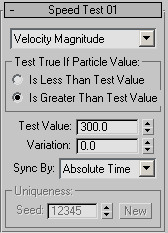 Command entry: Particle View
Command entry: Particle View  Click Speed Test in an event or add Speed Test to the particle system and then select it.
Click Speed Test in an event or add Speed Test to the particle system and then select it.
Speed Test lets the particle system check particle speed, acceleration, or the rate of circular travel, and branch accordingly. The test provides a number of variants that let you test speed or acceleration on specific axes, or simply whether the particle is accelerating or decelerating.

The user interface appears in the parameters panel, on the right side of the Particle View dialog.
The first interface element is a drop-down list that lets you choose the type of measurement to test:
An example of this option would be with fireworks: As the particles move upward, their velocity on the world Z axis is positive. When the reach the top of their trajectory and begin to move downward, their velocity on the world Z axis slows to 0, and then becomes negative. If you choose Velocity Z and Is Less Than Test Value, and set Test Value to 0.0, you can send particles to another event at the moment they begin to move downward.
For example, if a particle travels along a parabolic path, its motion has both linear and circular components. The circular component is greatest at the top of the parabola. If a particle travels in a full circle in one second, the rate is 360; if it travels in a half circle, the rate is 180.
Potential usage: When a particle is forced to turn too sharply, it might explode or change its type of movement. For example, missiles chase a jet fighter, which maneuvers to elude the missiles. The missiles are forced to change their course rapidly, but the missile construction cannot stand the fast change in steering, so the missiles blow up or disintegrate.
Lets you specify whether the test passes particles on to the next event if the speed test succeeds or fails. Available for all tests except True When Accelerates/Decelerates. Default=Is Greater Than Test Value.
By default, Speed Test returns True if the value tested for exceeds the Test Value quantity, but you can choose Is Less Than Test Value as well. For example, if you use the Velocity Magnitude test type and set Test Value=200 and Variation=0, and choose Is Less Than Test Value, then particles will move to the next event only when they travel faster than 200 units per second. Any particles traveling 200 units per second or slower stay in the current event unless they later exceed that speed or another test returns True.
The amount by which value tested for can vary randomly. Default=0.0.
To obtain the actual test value for each particle, the system multiplies the Variation value by a random number between -1.0 and 1.0, and then adds the result to the Test Value setting. For example, if Test Value=300 and Variation=10, then tested value for each particle would be between 290 and 310.
Choose the time frame to use when animating Test Value and Variation. For further information, see Animation Offset Keying group.